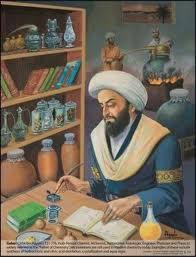
Muslim Scientists Jabir Ibn e Hayan
MUSLIM SCIENTISTS
Abu Musa Jabir Bin HaYyan
Jabir Bin Hayyan (Jaber) is one of the world's most great scientists, born and educated in Tus, Iran in 721 CE during the rule of Umayyad Khalifa. His father Hayyan al Azdi was a pharmacist who supported the Abbasid revolt against the Umayyad. The Abbasid sent him to Tus, Iran to gather support for their cause. He was eventually caught by ruling Khalifa and was executed, so his family moved from Tus to Yemen, where Jabir grew up. He went back to Kufa, Iraq after the fall of the Umayyad dynasty, where he lived and received his education. In Kufa he became the student of Imam Jafer al Sadiq. After completing his education he started his career as physician under the patronage of Vizier of Khalifa Harun al Rashid. His connection to the Vizier later on cost him dearly, when the Vizier fell from grace of the Khalifa. In 803 CE he was arrested and spent rest of his life under house arrest, till he died in year 815 CE.
He was a prominent polymath, a chemist and alchemist, astronomer and astrologer, engineer, geographer, philosopher, physicist, and pharmacist and physician. Jabir's interest in alchemy was probably inspired by his teacher Imam Jafar as-Sadiq (as). When he used to talk about alchemy, he would say "my master Jafar as-Sadiq (as) taught me about calcium, evaporation, distillation and crystallization and everything I learned in alchemy was from my master Jafar as-Sadiq (as). Imam Jafar (as) was famed for his depth and breadth of knowledge. In addition to his knowledge of Islamic sciences, Imam was well educated in natural sciences, mathematics, philosophy, astronomy, anatomy, chemistry (alchemy), and other subjects. The foremost Islamic alchemist Jabir bin Hayyan was his most prominent student. Other famous students of his were Imam Abu Hanifa and Imam Malik Ibn Anas. Jabir was called as an Arabic doctor and chemist, and the first to work and become a genius in old Chemistry where even Arab called general chemistry as "handiwork of Jabir". Jabir was the one who laid the foundations for modern and contemporary scientific chemistry.
Achievements
Jabir ibn Hayyan is widely considered as the father of Chemistry, but he was also an astronomer, pharmacist, physician, philosopher and engineer. His works in the science of chemistry are as important as those of eighteenth century scientists like Priestly and Lavoisier. He is credited for the discovery of nineteen different substances which we call element in modern chemistry. He was the first person to introduce the experimental method in chemistry. He introduced improvements to the evaporation methods of liquidation, distillation, fusion and crystallization. Using these methods he produced conc. acetic acid from vinegar. He also discovered Caustic soda (NaOH), Nitric acid, Hydrochloric acid and Sulfuric acid and termed it as or oil of vitriol. He successfully prepared a lot of chemicals like hydrated mercury and arsenious oxide. He prepared royal water or aqua regia, one of the few substances that can dissolve gold and is applied to gold extraction and purification. He also isolated citric acid from lemons and other unripe fruits, acetic acid from vinegar, and tartaric acid from wine-making residues. Jabir applied his chemical knowledge to the improvement of many manufacturing processes, such as making steel and other metals, preventing rust, engraving gold, dyeing and waterproofing cloth, tanning leather, and the chemical analysis of pigments and other substances. He developed the use of manganese dioxide in glassmaking, to counteract the green tinge produced by iron - a process that is still used today. He manufactured incombustible paper. He made some sort of paint that prevents iron rust. He first time introduced the method of separating gold from silver solution by acids, which is the predominant mode to this day He noted that boiling wine released a flammable vapor, thus paving the way to Al-Razi's discovery of ethanol.
Jabir divided the substance into three categories; first group he called Spirits substance which vaporize on heating, like sulfur, ammonium chloride, camphor and arsenic etc, second group he called Metals like copper, silver, gold, iron and lead etc the third group he called Non-malleable like rocks, charcoal . The categorizations of substance finally lead to divide the elements into the modern classification of elements into metals and non-metals.
This man was one of the greatest geniuses ever born, but we Muslims totally ignored him. On the other hand the Europeans translated his work into their languages and five hundred books and essays can be found in the national libraries of France, Germany and UK.


